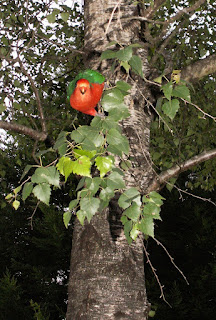Back Garden 1:
These are current photos: within the month of July 2008. There are some lovely areas-- until it is realized that the Garden contains several invasive species to Australia. Living in an area that borders the National Park and is home to many threatened and endangered species of flora and fauna heightens the need to take care of our gardens as a community.
I would like to chronicle the changes to this neglected Garden over time. This is the first step into the Back Garden. Right now it is affectionately known as "The Garden of Doom" from it's propensity to do things such as "eat tools" (breaking them in new ways), and the need during summer to enter armed with a machete as the growth is easily waist high. That is not a fun prospect, considering the fact that the yard is steeply sloped with a total of 5 terraces. When you are fighting through Cape Ivy, Blackberry, some other creeper and low branches from laurels trying to find the steps in the rocks and rain- weilding a machete, the idea of taking out as much as possible and safe during icey winter becomes a really good idea.
The Garden had had a minimal of "care" for somewhere around 10-15 years, by guestimate. This has allowed several invasive species to get a strong foothold.
But there is nothing that determination (and tools-- sharp and strong pointy ones) cannot overcome.
The below photos are entering the Back Garden from the steps and moving across Terrace 1, aka: Cottage Garden Terrace. These are all pre-clean-up. The plan for here is to stop the further spread downhill of the invasives by removal, replanting with non-invasive Cottage Garden plants such as roses, herbs, veggies, fruit trees and various species of Native Plants. There has been evidence of Bandicoot activity, so we are creating various habitat areas for them to arrange as they please. (Such as leaving old, hollowed stumps, or hollowing them myself to leave for shelters and such). Possums of various species also frequent here as well as gliders and quolls, as well as many bird species. In the clean-up process, natives are being left, cleared around, and habitats preserved.
And, yes, for those interested, I will be identifying plants.




The last photo is looking down the "steps" to the second Terrace.
From these photos one can see some of the dormant fruit trees, covered with Cape Ivy. Also various ferns, and the green, leathery grass clumps are called "Onion Grass", or Agapanthus. These are hellatious to remove and considered a bush invader. They have dense clumping roots, which I will show later, and those roots and it's spreading capabilities, displace all other vegitation.
 Glider eating my roses...
Glider eating my roses... Above and below-- Brush Tailed possums in the trees at the roof edge of the house. They are slightly larger than a house cat. Also- no relation to the American Opossums.
Above and below-- Brush Tailed possums in the trees at the roof edge of the house. They are slightly larger than a house cat. Also- no relation to the American Opossums.
 King Parrot saying hello while I was working under the birch tree in the front garden.
King Parrot saying hello while I was working under the birch tree in the front garden.






 Apple tree (foreground), Peach Tree (Midground, dark trunk) and Fern Trees.
Apple tree (foreground), Peach Tree (Midground, dark trunk) and Fern Trees.











































